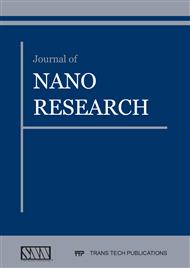[1]
R. L. Hoffman, Discontinuous and Dilatant Viscosity Behavior in Concentrated Suspensions. I. Observation of a Flow Instability, J. Rheol., 16 (1972) 155–174.
DOI: 10.1122/1.549250
Google Scholar
[2]
R. L. Hoffman, Discontinuous and dilatant viscosity behavior in concentrated suspensions. II. Theory and experimental tests, J. Colloid Interface Sci., 46, (1974) 491–506.
DOI: 10.1016/0021-9797(74)90059-9
Google Scholar
[3]
G. Bossis, J. F. Brady, The rheology of Brownian suspensions, J. Chem. Phys., 91 (1989) 1866–1874.
Google Scholar
[4]
A. A. Catherall, J. R. Melrose, R. C. Ball, Shear thickening and order–disorder effects in concentrated colloids at high shear rates, J. Rheol., 44 (2000) 1–25.
DOI: 10.1122/1.551072
Google Scholar
[5]
J. R. Melrose, R. C. Ball, Contact networks, in continuously shear thickening colloids, J. Rheol., 48 (2004) 961–978.
DOI: 10.1122/1.1784784
Google Scholar
[6]
J. R. Melrose, R. C. Ball, Continuous shear thickening transitions in model concentrated colloids—The role of interparticle forces, J. Rheol., 48 (2004) 937–960.
DOI: 10.1122/1.1784783
Google Scholar
[7]
X. Z. Zhang, W. H. Li, X. L. Gong, The rheology of shear thickening fluid (STF) and the dynamic performance of an STF-filled damper, Smart Mater. Struct., 17 (2008) 035027.
DOI: 10.1088/0964-1726/17/3/035027
Google Scholar
[8]
M. A. Dawson, Composite plates with a layer of fluid-filled, reticulated foam for blast protection of infrastructure, Int. J. Impact Eng., 36 (2009) 1288–1295.
DOI: 10.1016/j.ijimpeng.2009.03.008
Google Scholar
[9]
F. J. Galindo-Rosales, S. Martínez-Aranda, L. Campo-Deaño, CorkSTFμfluidics – A novel concept for the development of eco-friendly light-weight energy absorbing composites, Mater. Des., 82 (2015) 326–334.
DOI: 10.1016/j.matdes.2014.12.025
Google Scholar
[10]
S. Gürgen, M. C. Kuşhan, The effect of silicon carbide additives on the stab resistance of shear thickening fluid treated fabrics, Mech. Adv. Mater. Struct., 24 (2017) 1381–1390.
DOI: 10.1080/15376494.2016.1231355
Google Scholar
[11]
S. Gürgen, M. C. Kuşhan, High Performance Fabrics in Body Protective Systems, Mater. Sci. Forum, 880 (2016) 132–135.
DOI: 10.4028/www.scientific.net/msf.880.132
Google Scholar
[12]
S. Gürgen, The Influence of Boundary Condition on the Impact Behavior of High Performance Fabrics, Adv. Eng. Forum, 28 (2018) 47–54.
DOI: 10.4028/www.scientific.net/aef.28.47
Google Scholar
[13]
S. Gürgen, An investigation on composite laminates including shear thickening fluid under stab condition, J. Compos. Mater., In-press (2018).
DOI: 10.1177/0021998318796158
Google Scholar
[14]
A. Majumdar, B. S. Butola, A. Srivastava, Development of soft composite materials with improved impact resistance using Kevlar fabric and nano-silica based shear thickening fluid, Mater. Des., 54 (2014) 295–300.
DOI: 10.1016/j.matdes.2013.07.086
Google Scholar
[15]
S. Gürgen, M. C. Kuşhan, The ballistic performance of aramid based fabrics impregnated with multi-phase shear thickening fluids, Polym. Test., 64 (2017) 296–306.
DOI: 10.1016/j.polymertesting.2017.11.003
Google Scholar
[16]
S. Gürgen, M. C. Kuşhan, The stab resistance of fabrics impregnated with shear thickening fluids including various particle size of additives, Compos. Part Appl. Sci. Manuf., 94 (2017) 50–60.
DOI: 10.1016/j.compositesa.2016.12.019
Google Scholar
[17]
S. Gürgen, M. C. Kuşhan, W. Li, Shear thickening fluids in protective applications: A review, Prog. Polym. Sci., 75 (2017) 48–72.
DOI: 10.1016/j.progpolymsci.2017.07.003
Google Scholar
[18]
B. J. Maranzano, N. J. Wagner, Flow-small angle neutron scattering measurements of colloidal dispersion microstructure evolution through the shear thickening transition, J. Chem. Phys., 117 (2002) 10291.
DOI: 10.1063/1.1519253
Google Scholar
[19]
P. D'Haene, J. Mewis, G. G. Fuller, Scattering Dichroism Measurements of Flow-Induced Structure of a Shear Thickening Suspension, J. Colloid Interface Sci., 156 (1993) 350–358.
DOI: 10.1006/jcis.1993.1122
Google Scholar
[20]
J. W. Bender, N. J. Wagner, Optical Measurement of the Contributions of Colloidal Forces to the Rheology of Concentrated Suspensions, J. Colloid Interface Sci., 172 (1995) 171–184.
DOI: 10.1006/jcis.1995.1240
Google Scholar
[21]
W. H. Boersma, Computer simulations of shear thickening of concentrated dispersions, J. Rheol., 39 (1995) 841–860.
DOI: 10.1122/1.550621
Google Scholar
[22]
I. R. Peters, S. Majumdar, H. M. Jaeger, Direct observation of dynamic shear jamming in dense suspensions, Nature, 532 (2016) 214–217.
DOI: 10.1038/nature17167
Google Scholar
[23]
R. Mari, R. Seto, J. F. Morris, M. M. Denn, Shear thickening, frictionless and frictional rheologies in non-Brownian suspensions, J. Rheol., 58 (2014) 1693–1724.
DOI: 10.1122/1.4890747
Google Scholar
[24]
N. Y. C. Lin, B. M. Guy, M. Hermes, C. Ness, J. Sun, W. C. K. Poon, I. Cohen, Hydrodynamic and Contact Contributions to Continuous Shear Thickening in Colloidal Suspensions, Phys. Rev. Lett., 115 (2015) 228304.
DOI: 10.1103/physrevlett.115.228304
Google Scholar
[25]
S. Pednekar, J. Chun, J. F. Morris, Simulation of shear thickening in attractive colloidal suspensions, Soft Matter, 13 (2017) 1773–1779.
DOI: 10.1039/c6sm02553f
Google Scholar
[26]
A. Ghosh, A. Majumdar, B. S. Butola, Role of surface chemistry of fibres additives on rheological behavior of ceramic particle based Shear Thickening Fluids, Ceram. Int., In-press (2018).
DOI: 10.1016/j.ceramint.2018.08.213
Google Scholar
[27]
S. Gürgen, W. Li, M. C. Kuşhan, The rheology of shear thickening fluids with various ceramic particle additives, Mater. Des., 104 (2016) 312–319.
DOI: 10.1016/j.matdes.2016.05.055
Google Scholar
[28]
S. Gürgen, M. C. Kuşhan, W. Li, The effect of carbide particle additives on rheology of shear thickening fluids, Korea-Aust. Rheol. J., 28 (2016) 121–128.
DOI: 10.1007/s13367-016-0011-x
Google Scholar
[29]
S. Gürgen, M. C. Kuşhan, Rheological Properties of Shear Thickening Fluids, Journal of Polytechnic, 19 (2016) 409–414.
Google Scholar


